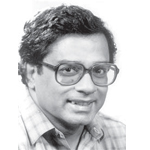Is the Gandhian influence still intact? It’s a difficult question which involves use of memory, knowledge, history and what not. In my 70’s, my recollections are vague. I know it is some VIP’s birthday. But whose?
On earlier occasions, we saw flags everywhere. Schools and offices were closed. A lot of people carried with them what was known as ‘charkhas’. Schoolboys and girls, men and women and senior citizens carried with them the ‘charkhas’ and could be seen spinning away on many locations. The resultant khadi bundles were given to khadi weavers who converted them into shirts, dhotis and so on. This was a never-ending activity year round, but on the 2nd day of October, the activities went on and on, and that was how Gandhi was celebrated.
There was no TV in those days. But there was more singing, not film songs, but patriotic songs, which found a place in films. Many of them were songs with patriotic themes. Gandhi was featured in these songs. Schools organised singing competition on Gandhi. My secondary years were spread among Madras, Madurai, Tindivanam, Vellore and Fort Kochi. I participated every year in these competitions, had a fairly decent voice, but not good enough to win prizes. But even participation was worthwhile, though the announcement ‘sweets to be distributed at the end of the competition’, was an additional incentive!
It was an age of innocence. I avidly practiced the patriotic songs featured in Tamil films sung by playback singers who were at the top. Music lovers of my generation often hummed Gandhian songs sung by the one and only ‘MS’ (M.S. Subbalakshmi), D.K. Pattamal, M.L. Vasanthakumari, N.C.Vasantha Kokilam and so on. Not just songs. Tamil culture warmly embraced bhajans, street plays (Theru koothu).The theme of Gandhi and Gandhi paadal (Gandhi songs) featured prominently in these cultural extravaganza. Some days after Gandhi’s assassination, the nation was enthralled by a patriotic Gandhi number sung by Mohammad Rafi, which went on for nearly 30 minutes – ‘Suno suno ae duniyawale, bapuji ki amar kahani’. It did not matter if you did not follow Hindi. Very soon, Tamil Nadu which had a special affinity for Bapu released the Tamil translated version sung by famous writer, actor-poet-singer Kothamangalam Subbu, and everyone was humming the song from public platforms, private halls, music recitals and so, yes, that one song won over the state and ‘Gandhi mahan’ became a household name.
Such was the simplicity, elegance and moving appeal of Gandhiji’s life that episodes from it easily lent themselves to various forms of presentation among different kinds of audiences, all over India. Again, Tamil Nadu led by a long way. Noted comedy couple N.S. Krishnan-T.A. Mathuram in their meaningful social comedy-message film Nalla Thambi (Good brother) packed with music and fun, highlighted the evils of drinking and the failure of prohibition. It was a new kind of message for the Tamil audience and its left-leaning messages found an impact even in distant Soviet Union.
A multi-cultural, multi-ethnic and multi-linguistic society like the one in India was ideal and easy for the spread of Gandhian ideals. Tamil Nadu with its strong cultural roots led the way. The Dravidian influence in the state ran parallel, and quite often the Dravidian and Gandhian influences, on issues like Untouchability, Prohibition and reliance on cottage industries, echoed similar sentiments.

 [/column]
[/column]